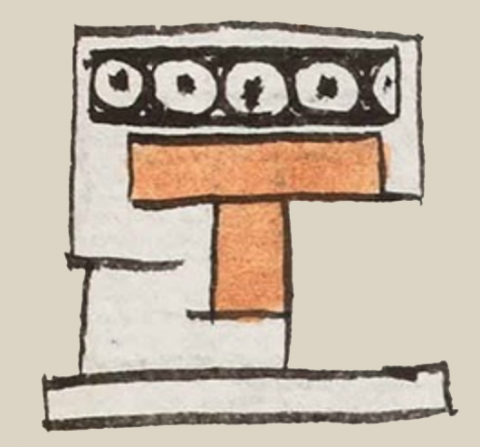tecpan (Mdz32r)
This simplex glyph of a royal palace (tecpan) stands for the place name, Tecpan. It is a profile of a building, with its entryway to our right. There is a row of four and a half concentric circles just below the roof. These circles are white within a black background. The inner circle is filled in with black. The lintel and side of the doorway are brown. The rest of the building—and its platform—are white. A building with a very similar design in another sixteenth-century source can be found in the Florentine Codex, Book II, f. 28 recto, and Book II, f. 106 verso.
Stephanie Wood
This glyph is very similar to the calli (house or generic building), except for the decoration just below the top of the building. These circles suggest power and prestige, and therefore they highlight how this is a royal palace and not just a house. One will also see the term tecpancalli employed to refer to royal palaces. Alonso de Molina's sixteenth-century vocabulary provides huei tecpan and huei tecpancalli, both having the modifier (huei) to indicate their larger size, an indication that palaces could vary in grandeur. Motecuhtzoma's palace in the Codex Mendoza has the circles at the top (see folio 69 recto), but they are not colored. The term tecpanchan (with the added -chan, for home) is somewhat rarer and seemingly later. A sixteenth-century building with the pattern of circles running horizontally below the roof survives still today in Teposcolula, Oaxaca, as shown in a photo by the editor of this database, taken in 2009. And here is a detail showing the circle alone. Various manuscripts show this type of decoration on the tecpan, too, such as we see in the map of the Relación Geográfica de Itztapalapa of 1580 or the Códice de Moctezuma in a scene published in Arqueología Mexicana.
In the see-also field, note how similar the architecture is for the tecpan in what is now the state of Morelos (from the AGN Ramo Hospital de Jesús).
Stephanie Wood
Stephanie Wood
c. 1541, or by 1553 at the latest
Stephanie Wood
Crystal Boulton-Scott made the SVG.
palaces, palacios

tecpan, royal palace, https://nahuatl.wired-humanities.org/content/tecpan
tecpancal(li), royal palace, https://nahuatl.wired-humanities.org/content/tecpancalli
royal palace
la casa real o el palacio
Stephanie Wood
Codex Mendoza, folio 32 recto, https://digital.bodleian.ox.ac.uk/objects/2fea788e-2aa2-4f08-b6d9-648c00..., image 74 of 188.
The Bodleian Libraries, University of Oxford, hold the original manuscript, the MS. Arch. Selden. A. 1. This image is published here under the UK Creative Commons, “Attribution-NonCommercial-ShareAlike 3.0 License” (CC-BY-NC-SA 3.0).




